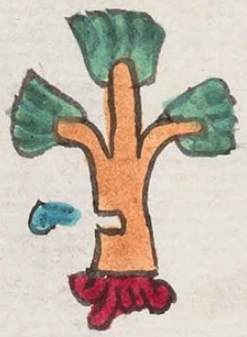Cuauhnahuac (Mdz7v)
This compound glyph for the place name Cuauhnahuac includes two main elements, a tree (cuahuitl) and a speech (nahuatl) scroll coming out of a mouth embedded in the tree trunk. The locative suffix (-c) is not shown visually. The tree has two branches and a leader, with a terracotta-colored trunk and foliage in two tones of green. It also has red rurling roots. The open mouth is on the left side of the trunk, and the curling speech scroll is a turquoise blue, emerging as though the tree were facing to the viewer's left.
Stephanie Wood
The speech scroll provides zero meaning to the reading of the glyph, but it does have a phonetic role, standing for the homophonic locative suffix (-nahuac), which means nearby.
Stephanie Wood
quauhnahuac.puo
Cuauhnahuac, pueblo
Stephanie Wood
c. 1541, or by 1553 at the latest
árboles, raíces, volutas

cuahui(tl), tree, https://nahuatl.wired-humanities.org/content/cuahuitl-1
nahua(tl), language/speech, language, https://nahuatl.wired-humanities.org/content/nahuatl
-nahuac (locative suffix), near, https://nahuatl.wired-humanities.org/content/nahuac
-c (locative suffix), https://nahuatl.wired-humanities.org/content/c
Codex Mendoza, folio 07 verso, https://digital.bodleian.ox.ac.uk/objects/2fea788e-2aa2-4f08-b6d9-648c00..., image 25, of 188.
The Bodleian Libraries, University of Oxford, hold the original manuscript, the MS. Arch. Selden. A. 1. This image is published here under the UK Creative Commons, “Attribution-NonCommercial-ShareAlike 3.0 License” (CC-BY-NC-SA 3.0).



